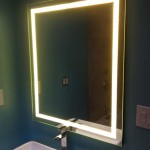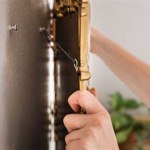The Versatile Elegance of Narrow Mirrors for Wall Décor
Mirrors, a staple in interior design, serve beyond their practical function of reflection. They enhance light, create the illusion of space, and contribute significantly to the overall aesthetic of a room. Among the diverse types of mirrors available, narrow mirrors designed for wall mounting offer a unique blend of functionality and style, particularly suitable for specific spatial challenges and design preferences. This article will examine the characteristics, applications, and key considerations for incorporating narrow mirrors into various interior spaces.
The term "narrow mirror" broadly describes mirrors with a significantly reduced width compared to their height. This elongated form factor lends itself to a range of design applications where larger, more conventional mirror shapes might be impractical or aesthetically unsuitable. Narrow mirrors can be framed or frameless, and they are available in a wide range of materials, finishes, and styles, from minimalist modern to ornate traditional designs, allowing for seamless integration into any existing décor scheme.
Space Optimization with Narrow Mirrors
One of the primary benefits of narrow mirrors is their ability to optimize space, particularly in areas where width is limited. Hallways, entryways, and bathrooms with narrow wall spaces are ideal candidates for this type of mirror. By strategically placing a narrow mirror on a wall, the perceived width of the space can be significantly increased. This effect is achieved by reflecting light and creating the illusion of depth, making a narrow room feel more open and airy. The visual trickery is especially effective in long, narrow hallways, preventing a claustrophobic feel and enhancing the sense of flow.
Furthermore, narrow mirrors can be used to visually break up long, unbroken stretches of wall. In a monotonous hallway, for example, a series of strategically placed narrow mirrors can create visual interest and prevent the space from feeling overly linear and dull. The placement can be symmetrical, creating a formal and balanced look, or asymmetrical, for a more contemporary and dynamic feel.
Beyond hallways, narrow mirrors find utility in smaller bathrooms. Often, bathroom design is constrained by limited square footage, making it challenging to incorporate a full-sized mirror without overwhelming the space. A narrow mirror, perhaps positioned above a pedestal sink or alongside a vanity, can provide essential functionality without sacrificing valuable space. The vertical orientation of the mirror also draws the eye upwards, contributing to the perception of greater ceiling height.
The strategic placement of narrow mirrors isn’t solely about expanding perceived space; it’s about maximizing light. When positioned opposite a window or other light source, these mirrors can effectively bounce light throughout the room, brightening darker corners and reducing the need for artificial illumination. This can contribute to a more energy-efficient and inviting atmosphere. The placement requires careful consideration of the angle of incidence of light to ensure optimal reflection and minimize glare. A consultation with a lighting designer or interior decorator can be beneficial in achieving the desired effect.
Enhancing Aesthetic Appeal Through Design Integration
Beyond their space-enhancing capabilities, narrow mirrors contribute significantly to the aesthetic appeal of a room. Their elongated shape offers a unique canvas for artistic expression and design integration. The frame, or lack thereof, plays a crucial role in determining the overall style. A sleek, frameless narrow mirror lends itself to a modern, minimalist aesthetic, while a mirror with an ornate, decorative frame can complement a traditional or vintage décor scheme.
The material of the frame is another important consideration. Options range from wood and metal to resin and glass, each offering a distinct visual texture and contributing to the overall design narrative. A wooden frame, for example, can add warmth and natural appeal to a space, while a metal frame can evoke a sense of industrial chic. The choice of material should be carefully considered in relation to the existing furniture and décor elements.
Narrow mirrors can also be incorporated into larger design compositions. They can be clustered together to create a gallery wall effect, offering a visually striking alternative to traditional artwork. The mirrors can be of varying sizes and shapes, creating a dynamic and eclectic mix. Alternatively, multiple identical narrow mirrors can be placed in a row, creating a sense of symmetry and visual rhythm. This approach is particularly effective above a console table or along a long hallway.
The use of decorative narrow mirrors extends beyond walls. They can be incorporated into furniture design, such as the doors of cabinets or the sides of dressers. This adds a touch of elegance and sophistication to the furniture piece, while also enhancing the reflective qualities of the surrounding space. This approach is particularly effective in bedrooms or dressing rooms where maximizing light and creating a sense of spaciousness is paramount.
The shape of the narrow mirror itself can also contribute to the overall aesthetic. While rectangular narrow mirrors are the most common, oval, arched, and even irregular shapes are available. These non-traditional shapes can add a touch of whimsy or artistic flair to a space, making them a focal point of the room. The selection of the shape should be guided by the overall design theme and the desired visual effect.
Key Considerations for Selecting and Installing Narrow Mirrors
Selecting and installing narrow mirrors requires careful consideration of several factors to ensure optimal functionality and aesthetic integration. The size of the mirror, the mounting hardware, and the surrounding décor all play a crucial role in achieving the desired outcome.
The size of the narrow mirror should be proportionate to the wall space and the surrounding furniture. A mirror that is too small can appear insignificant and lost, while a mirror that is too large can overwhelm the space. A general guideline is to leave a reasonable amount of empty wall space around the mirror to create a sense of balance. The height of the mirror should also be considered, ensuring that it is positioned at a comfortable viewing height for the intended users.
The mounting hardware is crucial for ensuring the safe and secure installation of the narrow mirror. The type of hardware required will depend on the weight of the mirror and the type of wall. For heavier mirrors, it is essential to use appropriate anchors that can support the weight. It is also important to ensure that the mounting hardware is hidden from view to maintain a clean and uncluttered aesthetic. Professional installation is recommended, especially for large or heavy mirrors.
The surrounding décor should be carefully considered when selecting a narrow mirror. The style of the mirror should complement the existing furniture and décor elements. For example, a modern narrow mirror with a sleek metal frame would be well-suited for a contemporary living room, while a traditional narrow mirror with an ornate wooden frame would be more appropriate for a Victorian-style bedroom. The color palette of the surrounding walls and furniture should also be taken into account. A mirror frame that contrasts too sharply with the surrounding colors can create a jarring visual effect.
Lighting is another critical consideration. The placement of the narrow mirror should be carefully considered in relation to the existing lighting fixtures. The mirror should be positioned to reflect light effectively, brightening the space and reducing shadows. However, it is important to avoid placing the mirror in a position where it will create glare or reflect direct sunlight, which can be uncomfortable for the eyes and potentially damage the mirror over time.
Finally, maintenance is an important consideration. Narrow mirrors, like all mirrors, require regular cleaning to maintain their reflective properties. A simple cleaning solution of water and vinegar is usually sufficient for removing dirt and grime. It is important to avoid using harsh chemicals or abrasive cleaners, which can damage the surface of the mirror. Regular cleaning will ensure that the narrow mirror continues to provide its intended functionality and aesthetic benefits for years to come.

Long Narrow Wall Mirror 35 8tall Gold Wood Framed Accent Luxurious Peruvian Decorative Length

Large Narrow Mirror Wall Decorations Handmade Long Hangings 39 4 Peruvian Silver Wood Framed On The Decor

Metal Frame Narrow Floor Mirror West Elm

Vintage Natural Narrow Framed Wall Mirror Com

Large Modern Narrow Hanging Mirror Home Wall Decor Gold Frame Peruvian Handmade Long On The Living Room

Mirrorize Designer Narrow Wall Mirror Set Of 3 Com

White Distressed Wall Mounted Narrow Mirror

Long Black Narrow Wall Mirror 35 4 Tall Painting On Glass Art Gold Leaf Wood Framed Decorative

Loving Living Small Vintage Mirror Wall Gallery Space Diy

Madlyn Long Narrow Wall Mirror








